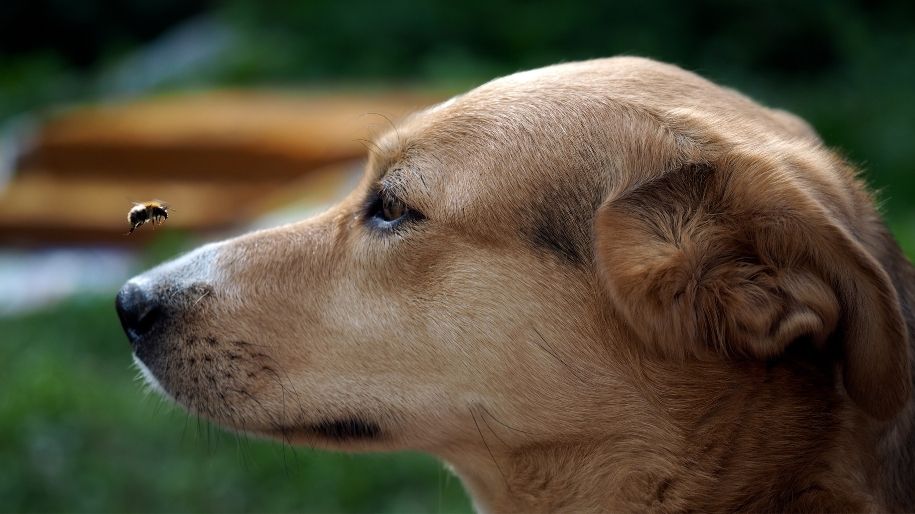As curious explorers, dogs often eat things they shouldn’t – including dead bees they find in the yard But is a dead bee dangerous for dogs to ingest? Here’s what you need to know if your pup eats a deceased bee
Will a Dead Bee Sting?
The good news is that a dead bee poses no stinging risk. Without an active defense reflex, a deceased bee cannot sting or inject venom.
However, dead bees can still cause oral irritation through contact with remnants of venom on their stingers or body. Reactions are typically mild.
So while eating a dead bee is not ideal, the bee itself is not directly hazardous once deceased.
Why Do Dogs Eat Dead Bees?
Dogs explore the world through their mouths, tasting and ingesting items that catch their interest. Some reasons dogs may eat dead bees include:
-
Instinct – Scavenging food sources like carrion is natural dog behavior
-
Texture – The fuzzy bee body intrigues dogs’ tactile senses.
-
Smell – Dead bees emit intriguing new odors as decomposition begins.
-
Taste – Dogs love sweet flavors, including sugars in nectar.
-
Curiosity – Dogs interact through taste to gather knowledge.
-
Prey drive – Chasing flying insects triggers dogs’ prey instincts.
-
Attention seeking – Eating bees gets a reaction from owners.
-
Nutritional need – Dogs may crave missing nutrients in their diet.
-
Boredom – Inactive dogs find bees mentally stimulating.
Satisfying natural drives to scavenge, explore, play, and learn motivates most bee-eating. It’s not random behavior.
Signs of a Reaction After Ingesting a Dead Bee
Though dead bees don’t sting, oral irritation can occur from toxins released as bees decompose. Watch for these signs:
- Pawing at the mouth
- Excessive drooling
- Swallowing or head shaking
- Reddened gums or tongue
- Hives or swollen face/muzzle
- Coughing or gagging
Mild symptoms typically fade within a day. If moderate tongue/mouth swelling occurs, an antihistamine like Benadryl may provide relief. Severe swelling requires prompt veterinary treatment.
What to Do If Your Dog Eats a Dead Bee
Don’t panic if you catch your dog munching a deceased bee. Follow these tips:
- Remove any remaining bee parts from the mouth.
- Offer water to dilute saliva and flush the mouth.
- Monitor for signs of irritation the next 24 hours.
- Call your vet if substantial swelling or distress occurs.
- Avoid inducing vomiting, which could worsen irritation.
Use positive reinforcement to redirect your dog’s attention to more appropriate chew toys in the future.
Can Dead Bees Cause Long-Term Harm?
In most cases, dogs suffer no lasting effects from eating a dead bee. Exceptions include:
-
Allergic reaction – Severe swelling indicates allergy requiring veterinary treatment.
-
Toxin buildup – Repeated bee ingestion may accumulate venom toxins over time.
-
Obstruction – Sharp stingers could puncture or block the intestines if swallowed whole.
-
Decayed bees – Eating old, rotted bees risks bacterial or fungal infection.
-
Pesticides – Bees may contain residual pesticides from the hive.
Unless these specific issues are present, a single dead bee poses little long-term risk.
Preventing Your Dog From Eating Bees
You can discourage bee and insect eating through these tactics:
-
Use positive reinforcement to teach your dog “leave it” and “drop it.”
-
Distract your dog from dead bees with toys, treats, or play.
-
Keep your dog leashed or away from known bee areas.
-
Eliminate food bowls outside that attract bees.
-
Remove bee and wasp nests safely from your property.
-
Make your yard unappealing to bees with landscape choices.
-
Ensure your dog’s diet offers complete nutrition so they don’t scavenge.
-
Provide plenty of exercise and mental stimulation to prevent boredom.
With patience and consistency, you can curb your dog’s desire to snack on deceased bees and other insects when outside. Stay vigilant since prevention is the best solution.
Can a dog have an allergic reaction to a bee sting?
Yes, some dogs can have an allergic reaction to a bee sting. Signs of an allergic reaction may include hives, difficulty breathing, and collapse. If you suspect your dog is having an allergic reaction, seek veterinary care immediately.
My Dog Ate A Dead Bee: What To Do After A Dog Is Stung By A Bee?

If your dog has eaten a dead bee, you may wonder what to do next. Here is what you should do:
What happens if a dog eats a dead bee?
Can a dog die from eating a bee?
Dogs can have an allergic reaction to bee stings, which may result in difficulty breathing, vomiting, diarrhea, weakness, and even collapse. If your dog eats a bee before it dies, it’s possible for the dog to die from the bee sting.
What should I do if my dog ate a bee?
If your dog ate a bee, observe it carefully for at least an hour. Look for symptoms like swelling, drooling, or pawing at the mouth. If your dog shows any of these symptoms, has allergies, or has been stung by multiple bees, immediately contact your veterinarian, take it to a local clinic, or call pet poison control.
Can dogs eat bees?
Eating bees can pose a problem for dogs, primarily due to the risk of being stung before the bee dies. The sting releases venom into the tissue, leading to reactions such as swelling, redness, pain, and heat. These reactions can range from mild to severe, potentially causing serious and immediate problems for the dog.
Can a dog eat a bee sting?
A dog cannot eat a bee sting, most dogs will only suffer relatively mild symptoms following a bee or wasp sting. They’ll experience some localized pain and swelling, and they’ll probably make a mental note to avoid eating bees and wasps in the future.

